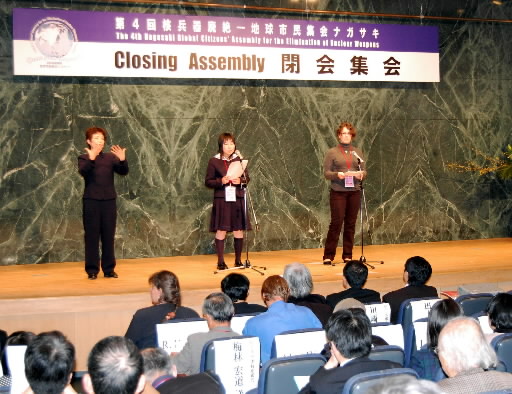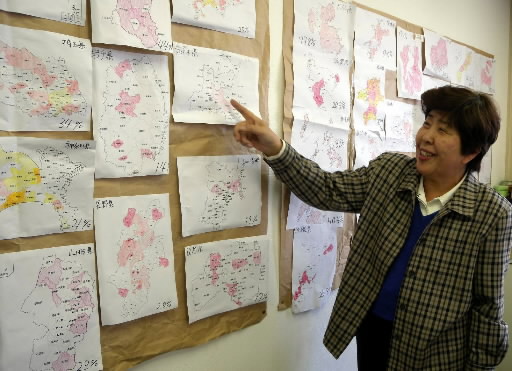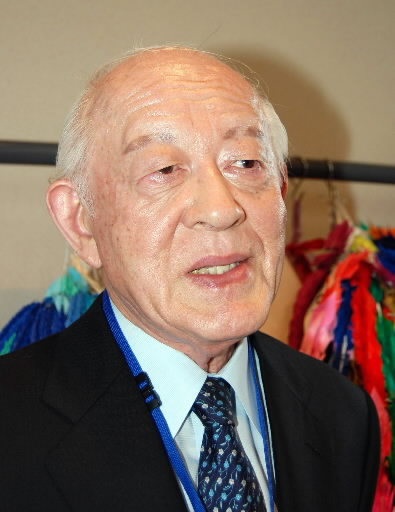Nuclear weapons can be eliminated: Special Series, Part 13
Feb. 26, 2010
Special Series: The Day the Nuclear Umbrella is Folded
Part 13: Impacting the world with the power of citizens
by the "Nuclear Weapons Can Be Eliminated" Reporting Team
One of the obstacles involved in eliminating the world of nuclear weapons is "the theory of states" in which nations in possession of nuclear weapons are considered to hold a political advantage. But the appeal of the A-bomb survivors, who suffered the inhumanity of nuclear weapons, and the power of citizens in understanding, supporting, and spreading the survivors' appeal can help put this notion to rest. In this part of our special series, we report on the efforts of citizens of Hiroshima and Nagasaki and explore the possibility and the importance of citizens impacting the world.
Disseminating the Nuclear Weapons Convention to the world
Nearly 400 people working for NGO groups involved in making efforts for a nuclear-free world, both in Japan and abroad, visited the A-bombed city of Nagasaki to take part in the "4th Nagasaki Global Citizens Assembly for the Elimination of Nuclear Weapons" held February 6~8. One of the main subjects of discussion, and included in the Nagasaki Appeal adopted on February 8, was the Model Nuclear Weapons Convention.
Such a convention would prohibit every aspect of nuclear weapons, from development and production to possession and nuclear testing. The Comprehensive Test Ban Treaty (CTBT) is unlikely to be realized in the near future and the negotiation for the Fissile Material Cut-off Treaty has not yet commenced. Though the Nuclear Non-Proliferation Treaty (NPT) imposes nuclear disarmament on its member nations, it permits some countries to possess nuclear weapons. Under these circumstances, it is hoped that pursuing a Nuclear Weapons Convention would prompt a breakthrough in abolition efforts.
The draft of the convention was formulated in 1997 by international NGOs, after they undertook strenuous efforts to encourage the advisory opinion from the International Court of Justice (ICJ) in 1996 that "any threat or use of nuclear weapons would generally be contrary to the rules of international law." A revised draft of the model convention was then issued in 2007.
Stressing the significance of the convention, Rebecca Johnson, 55, director of the Acronym Institute for Disarmament Diplomacy in the United Kingdom, said, "The advisory opinion by the ICJ should be developed and nuclear weapons, considered to be a crime against humanity, should be outlawed." Ms. Johnson was involved in drafting the model convention and she attended the meeting in Nagasaki.
Haruko Moritaki, 71, co-director of the Hiroshima Alliance for Nuclear Weapons Abolition (HANWA), was in Nagasaki with Ms. Johnson. Ms. Moritaki, with the leading role that international NGOs played in realizing the Land Mine Ban Treaty and the Convention on Cluster Munitions in mind, said, "The convention provides a good opportunity for the A-bombed cities and their citizens to work together." She believes that clarifying the illegality of the use of nuclear weapons through a convention would lead directly to rejecting the "nuclear umbrella."
Against the backdrop of rising enthusiasm from citizens, Costa Rica and Malaysia submitted the Model Nuclear Weapons Convention as a governmental document to the Preparatory Committee for the 2007 NPT Review Conference. In 2008, the model convention was submitted at the UN General Assembly. In his nuclear disarmament plan proposed in the same year, UN Secretary-General Ban Ki-moon indicated his high regard for the convention.
Challenges, of course, remain to be solved. On the national level, nuclear weapons are linked to security strategy more directly and deeply than landmines and other munitions. This makes it difficult for national leaders to sit down at the negotiating table to discuss the Model Nuclear Weapons Convention.
"For the first stage of our efforts, we will do our utmost so that as many countries as possible will refer to the Model Nuclear Weapons Convention in their speeches at the NPT Review Conference this May," said Hiromichi Umebayashi, special advisor to the non-governmental organization Peace Depot. Mr. Umebayashi is determined to make steady efforts to achieve this aim.
Hiroshima citizens are also actively engaged in efforts to see a successful outcome to the Review Conference.
Maeko Nobumoto, 61, secretary general of the "Yes! Campaign," a Hiroshima-based citizens' group, pointed at the map of Japan on the wall of the group's office. Japanese municipalities which have agreed to support the "Hiroshima-Nagasaki Protocol," a road map outlining a series of steps leading to nuclear abolition by the year 2020, in response to the appeal of members of the group's caravan teams, including A-bomb survivors, are colored on the map. Among 1,772 cities in Japan, more than 730 municipalities have indicated support for the protocol.
The caravan teams were launched by the "Yes! Campaign" on July 25, 2009. Eight team members, including A-bomb survivors, take turns visiting municipalities across Japan. Sometimes, the caravan team has faced disappointment. For instance, Shibuya Ward, Tokyo, home to a mural by Taro Okamoto which expresses an antinuclear sentiment, rebuffed the team's visit.
"Many municipal leaders and other officials listen to us intently when we share our experiences of the bombing," said Toshiko Tanaka, 71, who experienced the atomic bombing of Hiroshima a few kilometers from the hypocenter. Ms. Tanaka was surprised to learn that not many people outside Hiroshima have heard details of the survivors' experiences, even in Japan. "Our generation still has a lot to do," she said.
The "Yes! Campaign" is planning to call on the Japanese government to propose at the 2010 NPT Review Conference that the Hiroshima-Nagasaki Protocol be adopted at the gathering. Tomoko Watanabe, 56, a member of the "Yes! Campaign," said, "We're well aware of the difficulty involved in citizens moving out ahead of the government." She went on to explain, "The Japanese government is reluctant to take strong action for nuclear abolition, out of concern over the U.S. response. In this sense, citizens, who are better connected to the world, are taking the lead in Japan."
Major contents of the Model Nuclear Weapons Convention
The use and threat of use of nuclear weapons are prohibited. The development, testing, stockpiling, producing, or transferring of nuclear weapons are also prohibited.
No later than 15 years after entry into force of this Convention, all nuclear weapons shall be destroyed.
The Convention applies rights and obligations to individuals as well as states.
An agency would be established to implement the Convention.
At least [65] States in total have deposited instruments of ratification.
Withdrawal from this Convention shall not be permitted
Excerpts are from "Securing Our Survival (SOS): The Case for a Nuclear Weapons Convention" published by International Physicians for the Prevention of Nuclear War, International Association of Lawyers Against Nuclear Arms, and International Network of Engineers and Scientists Against Proliferation
Interview with Hideo Tsuchiyama, former president of Nagasaki University: Currents in the peace movement
Hideo Tsuchiyama, 84, former president of Nagasaki University, plays a leading role in the Nagasaki peace movement and served as the chair of the executive committee which organized the 4th Nagasaki Global Citizens' Assembly for the Elimination of Nuclear Weapons. Below are Mr. Tsuchiyama's profile and his thoughts on the role of citizens.
Hideo Tsuchiyama
Hideo Tsuchiyama was born in 1925 in the city of Nagasaki. He was exposed to radiation upon entering Nagasaki after the atomic bombing of that city while a medical student at Nagasaki Medical College (currently Nagasaki University School of Medicine). He served as president of Nagasaki University from 1988 to 1992. He is a member of the Committee of Seven for World Peace.
New trend in conveying views to the government
There were three subjects of discussion at this assembly: 1) measures that should be taken by Japan with regard to the "nuclear umbrella"; 2) the realization of a Nuclear Weapons Convention; and 3) handing down the experience of the atomic bombings to second-generation A-bomb survivors and the generation born after World War II. Participants took part in lively discussions and made concrete proposals for each topic. Conveying the constructive opinions of citizens to the government is a new development in the campaign to eliminate nuclear weapons. I feel that a trend is forming.
The arrival of the Obama administration in the United States serves as a tailwind for nuclear abolition. The A-bomb survivors are pleased. "Our message is finally starting to be heard in the world," they say. Nonetheless, the potential of civil society in the arena of nuclear abolition, without depending on U.S. President Obama, is being tested.
Differences in intention and motivation between the U.S. and Japan
President Obama himself clearly stated that "…as long as these weapons exist, the United States will maintain a safe, secure and effective arsenal to deter any adversary…" At the same time, the recommendations made for preventing nuclear proliferation and nuclear terrorism by four former high-ranking U.S. officials, including George Shultz, the former secretary of state, in op-ed articles published in the Wall Street Journal, were borne from a strategic judgment. In this light, the U.S. stance toward nuclear weapons hasn't really changed.
Meanwhile, Japan's campaign to eliminate nuclear weapons is based on the ethical and moral idea that "nuclear weapons must never be abided" from the standpoint of the A-bomb experiences. The Model Nuclear Weapons Convention is also based on the same idea. Though both Japan and the United States share the same cause, the intention and motivation behind the two nations' actions are very different. This should be clearly understood.
Continuous critique and challenge from the public
We should not blindly welcome the ideals of President Obama. Citizens should view these ideals with a critical eye and call on Mr. Obama to put his ideals into practice. By the same token, we should challenge the Japanese government's attitude of relying on the U.S. nuclear umbrella responding to force with force.
The rocky path toward nuclear abolition has not changed. Many obstacles must be overcome. We should brace ourselves and continually provide ideas from the perspective of citizens to overcome all difficulties.
Keywords
The International Court of Justice (ICJ)
The ICJ is located in the Hague, the Netherlands. It is authorized to solve legal international disputes between nations or to state advisory opinions on legal questions referred to it by international organs. The ICJ examined the legality of the use of nuclear weapons in response to a request from the United Nations. In 1995, former Hiroshima Mayor Takashi Hiraoka argued that nuclear weapons are contrary to international law, despite the fact that the Japanese government did not share this stance. In its advisory opinions in 1996, the ICJ ruled that "the threat or use of nuclear weapons would generally be contrary to the rules of international law." But at the same time, the opinion stated, "The Court cannot conclude definitively whether the threat or use of nuclear weapons would be lawful or unlawful in an extreme circumstance of self-defense, in which the very survival of a state would be at stake."
(Originally published on February 14, 2010)
To comment on this article, please click the link below. Comments will be moderated and posted in a timely fashion. Comments may also appear in the Chugoku Shimbun newspaper.










